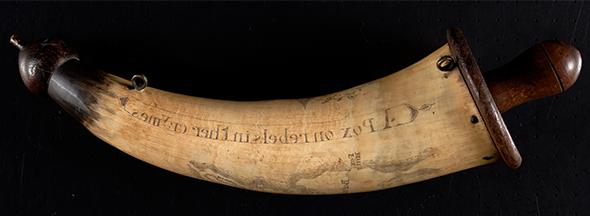By Allison K. Lange, PhD
We expect to see maps on paper, not on animal horns. Maj. Samuel Selden might have thought this as he etched a map of Boston on his powder horn, which is dated 9 March 1776. During the Revolutionary War, soldiers used animal horns to hold their gunpowder. They filled them at the larger end and funneled the powder into their weapons. Not all militiamen had their own powder horns, so men like Selden carved unique designs on them in order to claim them as their own.

Selden was a member of Connecticut’s Provincial Assembly and became a major in the colony’s militia during the war. He served under George Washington’s direction during the siege of Boston. His powder horn depicts the sites of American fortifications as well as the positions of the Continental Army just before the British evacuated the city.
Even if we did not know Selden’s background, his carvings convey his allegiances. A ship labeled “Amaraca” displays a Continental Union flag. Another flag depicts the Liberty Tree, the tree near the Boston Common where locals met to protest British rule. Alongside his name, Selden also inscribed the words: “made for the defense of liberty.”

Selden’s map is a pictorial map rather than one focused on the area’s geography. His detailed carvings feature individual ships in the harbor and houses lining the Boston neck. Crosshatching adds depth to the water and makes his lettering stand out. In contrast, a 1775 powder horn housed at the Norman B. Leventhal Map Center features a more traditional map of Boston. Instead of pictures, this map traces shorelines. Unlike Selden’s, however, a British soldier carved this powder horn. He inscribed the words: “A Pox on rebels in ther crymes [their crimes].”

Photo courtesy of Norman B. Leventhal Map Center.
Just six months after Selden carved his horn, the British captured him at the Battle of Kip’s Bay during their campaign to take control of New York City. The prison’s conditions were poor. Less than a month later, Selden fell ill and died on 11 October 1776.
Selden’s powder horn, as well as that of his British counterpart, is currently on display in the Norman B. Leventhal Map Center’s exhibition at the Boston Public Library. The exhibition, We Are One: Mapping America’s Road from Revolution to Independence, uses maps to explore the events that led thirteen colonies to forge a new nation. We Are One demonstrates that maps, from Selden’s carving to early European maps of the new nation, were central to the revolutionary process. The exhibition features maps as well as prints, paintings, and objects from the Leventhal Map Center’s own collection and those of twenty partners, including the British Library and Library of Congress. Visit zoominginonhistory.com to explore geo-referenced maps from the exhibition.
The exhibition will be on display at the Boston Public Library through November 29, 2015. We Are One then travels to Colonial Williamsburg from February 2016 through January 2017 and to the New-York Historical Society from November 2017 through March 2018.
The Leventhal Map Center also hosts the NEH-funded American Revolution Portal database. Researchers can access maps from the Massachusetts Historical Society, British Library, Library of Congress, and other institutions in one search. Users can download images for research and classroom use. Access these resources and learn more about We Are One at maps.bpl.org/WeAreOne.
Find out more about the Society’s own map collection at their upcoming exhibition: Terra Firma: The Beginnings of the MHS Map Collection, which opens on 2 October. Through 4 September, visitors to the MHS can learn more about the American Revolution with exhibition: God Save the People! From the Stamp Act to Bunker Hill.
Image 1: Selden, Samuel, 1723-1776. [Powder horn scribed by Samuel Selden.] Lyme, Conn., 1776. 1 powder horn: ivory; 37 x 21 x 13.3 cm. Massachusetts Historical Society.
Image 2: Detail of above.
Image 3: E.B., [Powder Horn with Map of Boston and Charlestown]. [Boston], 1775. Scrimshaw horn, 14 x 3.5 x 3.5 inches. Norman B. Leventhal Map Center.








